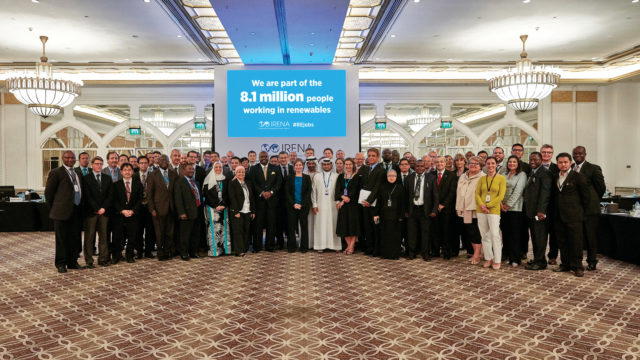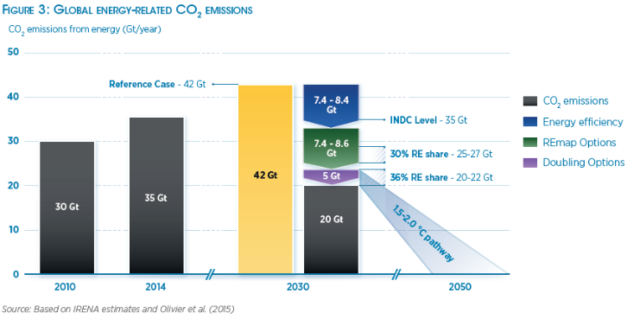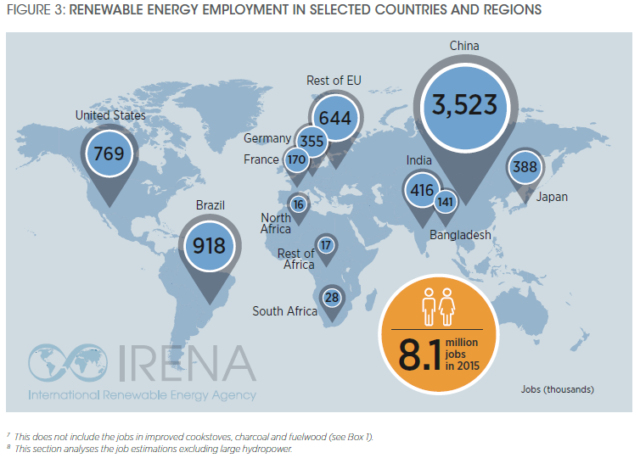Two research reports released this month by IRENA (International Renewable Energy Agency) highlight the economic, social, and environmental benefits derived from global investment in and deployment of renewable energy.
IRENA’s goal was to account for the ¨externalities¨ omitted in traditional economic analysis of fossil fuel development and use. In ¨The True Cost of Fossil Fuels,¨ IRENA determined that doubling the share of renewables in the global energy mix by 2030 could reduce the human and environmental health impacts of pollution and climate change to the tune of more than 4 million lives and some $4.2 trillion per year worldwide, 15 times the associated costs.

The May 25 release of ¨Renewable Energy and Jobs – Annual Review 2016¨ during Abu Dhabi-based IRENA’s 11th Council Meeting revealed that more than 8.1 million people worldwide were employed in the renewable energy industry in 2015, up 5% year-over-year (YoY). Adding to a rising trend, growth in renewable energy jobs stands out in sharp contrast to the job losses in the broader energy sector, IRENA explains in a news release.
Putting a Number on the True Cost of Fossil Fuels
¨Today’s energy markets…do not adequately value climate impact or air pollution,¨ IRENA points out in its research brief. ¨Energy and environmental policies need to correct for these externalities.¨

The impact of air pollution caused by fossil fuel development and use is just one of the many environmental and health factors ignored in traditional project and investment analysis. Other factors are the negative impacts of extreme weather events and long-term climate change, all of which result in the loss of ecosystems and biodiversity as well as deterioration in human health and quality of life.
To account for these externalities, IRENA researchers quantified those associated with ¨air pollution and climate change related to fossil fuels and the extent to which these can be reduced with higher uptake of renewables,¨ the report authors explain. In doing so, they compared projections of global energy demand between today and 2030 for two cases: one based on current and planned energy policies and a second based on doubling the share of renewable energy within 15 years.
Other key findings:
- Doubling the renewable share in the global energy mix can result in significant fossil-fuel savings. Compared to the 2030 Reference Case, coal, oil, and natural gas supplies can be reduced by 22%, 11%, and 11%, respectively, while primary renewable energy supply could increase by up to 46% over the coming 15 years.
- Modern renewables include multiple types of sustainable, cost-effective bioenergy and biofuels, which comprise crucial elements in the energy transition. The envisaged scale-up of modern renewables also allows for the phase-out of traditional bioenergy uses that involve unsustainable fuel gathering and toxic combustion.
- Reduced use of fossil fuels allows the avoidance of carbon dioxide (CO2) emissions and air pollutants. With the renewable share doubled, particulate matter (PM2.5) emissions that result in serious adverse effects on human health would be reduced by 33% compared to today’s levels. Likewise, emissions of mono-nitrogen oxides (NOx), sulphur dioxide (SO2), ammonia (NH3) and volatile organic compounds (VOCs), all of which have serious health effects, would also be lower than today’s levels.
- Doubling the share of renewables, combined with significant increases in energy efficiency, would halve energy-related CO2 emissions in 2030, in comparison to current and planned energy policies. These substitutions would reduce externalities by at least USD 1.2 trillion per year and as much as USD 4.2 trillion per year by 2030, in comparison to current policies. Much of this reduction relates to indoor and outdoor air pollution.
- Doubling renewables in the global energy mix could save up to 4 million lives annually by 2030. This compares with 3.7 million premature deaths from ambient air pollution and 4.3 million deaths from household air pollution in 2012, according to World Health Organization (WHO) figures.
RE Jobs: An Upward Trajectory
Nationally, the number of renewable energy jobs was highest in China, Brazil, the U.S., India, Japan and Germany in 2015, according to IRENA’s latest annual review.

In terms of technology, more people were working in the solar photovoltaic (PV) industry than any other: 2.8 million, up from 2.5 million at IRENA’s last count. Liquid biofuels was the second largest employer, employing 1.7 million. Wind power jobs followed, increasing 5% YoY to reach 1.1 million.
In the U.S., renewable energy industry employment rose 6% YoY in 2015 while oil and gas industry employment dropped 18%. Furthermore, some 3.5 million Chinese are employed in the country’s renewable energy industry. That’s nearly 1 million more than those working in China’s oil and gas sector, IRENA notes. Coupled with ongoing declines in the costs of deploying renewable energy technology, supportive energy policy frameworks spurred industry job growth in 2015.
¨We expect this trend to continue as the business case for renewables strengthens and as countries move to achieve their climate targets agreed in Paris,” explains Director-General Adnan Z. Amin.¨We expect this trend to continue as the business case for renewables strengthens and as countries move to achieve their climate targets agreed in Paris.”
